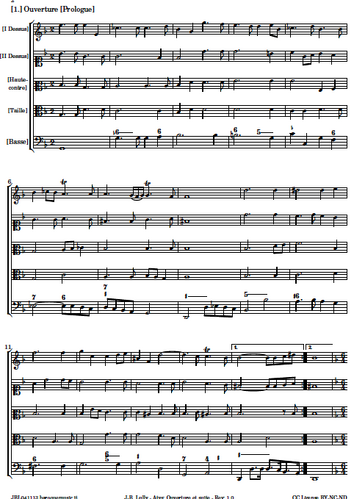Introduction[]
Jean Baptiste Lully held somewhat of a monopoly on French opera in the Mid Baroque period (Golden 2010). He wrote in two dramatic styles, one being comedie ballets and the other tragedie lyrique. "Atys" falls under the latter category as a tragedie lyrique. These types of works were considered true operas in that they were sung throughout (Golden 2010). They were structurally modeled on classical dramas.
Analysis[]

This tragédie lyrique is in a five act format with a prologue, which was typical of this genre in the mid Baroque period. Per usual in this genre, this work is based on mythological plots. Dance rhythms abound beginning at the beginning of the work in the first couple measures of the overture. Dotted rhythms form dance characteristics and give clues to listeners to that this music belongs to the French Baroque period. As a French composition, the dotted rhythms are even heard as "overdotted" (Golden 2010). The instrumentation used throughout is thicker than the earlier Baroque period and consists of a larger string section, almost characteristic of the later full orchestra. The overture has two main parts, with somewhat of a return to the first section. As typical in this period, the first part is stately with dotted rhythms in a duple meter. The second part is in a triple meter (6/4) with a faster feel, which is also typical for this period of music (Gorce 2014). French recitative, aria, and choruses are all heard throughout "Atys." Recitative begins in measure 43 and has qualities of French recitative, which was commonly more melodic and less "speech-like" than Italian recitative (Golden 2010). The music is not overly ornamented as some other Baroque music. This was primarily because Lully avoided overly complex ornamentation because it would mask the importance of the text and drama, something French audiences particularly valued (Gorce 2014).
Comparison[]
"Atys" is highly similar to "Armide," one of Lully's most famous tragedie lyrique works. Both have a five act format with a prologue and begin with a stately overture. Dotted and dance rhythms abound in both works, particularly in the opening instrumental overtures. "Armide" makes greater use of percussion than "Atys." A thicker orchestration is characteristic in both works. Overly complex ornamentation is avoided in "Armide" just as in "Atys." Both the overtures in the two pieces have an ABA form, with a stately, duple section followed by a faster, fugal, triple metered section. Both works are composed on mythological story lines.
Observations[]
For me, the opera is one of the most interesting genres emerging in the mid Baroque era. I enjoy the thicker ornamentation and find the opening, stately overtures interesting to listen to. While I understand the differences between recitative and aria, I do find them much more difficult to distinguish between in French opera than Italian opera, which makes sense considering French recitative is more melodic and less "speech-like."
Works Cited[]
"Jean-Baptiste Lully- Atys." YouTube video, 3:15:57. Posted by "Leonardo Vinci," upload April 17, 2013. http://www.youtube.com/watch?v=K8dF8WSHngY
Mario Bolognani (editor). Atys. Creative Commons Attribution. http://imslp.org/wiki/Atys,_LWV_53_(Lully,_Jean-Baptiste)
Rachel Golden. (2010, September) Renaissance Period. Musicology 210. Lecture conducted from University of Tennessee, Knoxville. Jéróme de La Gorce. "Lully." Grove Music Online. Oxford Music Online. Oxford University Press, accessed February 27, 2014, http://www.oxfordmusiconline.com/subscriber/article/grove/music/42477pg1
